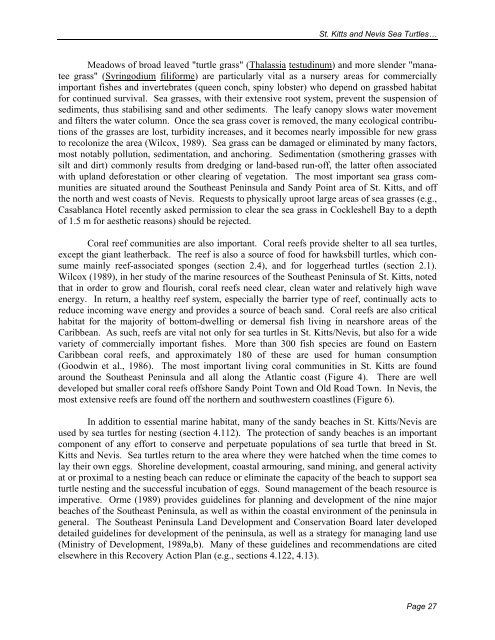Sea Turtle Recovery Action Plan for St. Kitts and Nevis - WIDECAST
Sea Turtle Recovery Action Plan for St. Kitts and Nevis - WIDECAST
Sea Turtle Recovery Action Plan for St. Kitts and Nevis - WIDECAST
Create successful ePaper yourself
Turn your PDF publications into a flip-book with our unique Google optimized e-Paper software.
<strong>St</strong>. <strong>Kitts</strong> <strong>and</strong> <strong>Nevis</strong> <strong>Sea</strong> <strong>Turtle</strong>s…<br />
Meadows of broad leaved "turtle grass" (Thalassia testudinum) <strong>and</strong> more slender "manatee<br />
grass" (Syringodium fili<strong>for</strong>me) are particularly vital as a nursery areas <strong>for</strong> commercially<br />
important fishes <strong>and</strong> invertebrates (queen conch, spiny lobster) who depend on grassbed habitat<br />
<strong>for</strong> continued survival. <strong>Sea</strong> grasses, with their extensive root system, prevent the suspension of<br />
sediments, thus stabilising s<strong>and</strong> <strong>and</strong> other sediments. The leafy canopy slows water movement<br />
<strong>and</strong> filters the water column. Once the sea grass cover is removed, the many ecological contributions<br />
of the grasses are lost, turbidity increases, <strong>and</strong> it becomes nearly impossible <strong>for</strong> new grass<br />
to recolonize the area (Wilcox, 1989). <strong>Sea</strong> grass can be damaged or eliminated by many factors,<br />
most notably pollution, sedimentation, <strong>and</strong> anchoring. Sedimentation (smothering grasses with<br />
silt <strong>and</strong> dirt) commonly results from dredging or l<strong>and</strong>-based run-off, the latter often associated<br />
with upl<strong>and</strong> de<strong>for</strong>estation or other clearing of vegetation. The most important sea grass communities<br />
are situated around the Southeast Peninsula <strong>and</strong> S<strong>and</strong>y Point area of <strong>St</strong>. <strong>Kitts</strong>, <strong>and</strong> off<br />
the north <strong>and</strong> west coasts of <strong>Nevis</strong>. Requests to physically uproot large areas of sea grasses (e.g.,<br />
Casablanca Hotel recently asked permission to clear the sea grass in Cockleshell Bay to a depth<br />
of 1.5 m <strong>for</strong> aesthetic reasons) should be rejected.<br />
Coral reef communities are also important. Coral reefs provide shelter to all sea turtles,<br />
except the giant leatherback. The reef is also a source of food <strong>for</strong> hawksbill turtles, which consume<br />
mainly reef-associated sponges (section 2.4), <strong>and</strong> <strong>for</strong> loggerhead turtles (section 2.1).<br />
Wilcox (1989), in her study of the marine resources of the Southeast Peninsula of <strong>St</strong>. <strong>Kitts</strong>, noted<br />
that in order to grow <strong>and</strong> flourish, coral reefs need clear, clean water <strong>and</strong> relatively high wave<br />
energy. In return, a healthy reef system, especially the barrier type of reef, continually acts to<br />
reduce incoming wave energy <strong>and</strong> provides a source of beach s<strong>and</strong>. Coral reefs are also critical<br />
habitat <strong>for</strong> the majority of bottom-dwelling or demersal fish living in nearshore areas of the<br />
Caribbean. As such, reefs are vital not only <strong>for</strong> sea turtles in <strong>St</strong>. <strong>Kitts</strong>/<strong>Nevis</strong>, but also <strong>for</strong> a wide<br />
variety of commercially important fishes. More than 300 fish species are found on Eastern<br />
Caribbean coral reefs, <strong>and</strong> approximately 180 of these are used <strong>for</strong> human consumption<br />
(Goodwin et al., 1986). The most important living coral communities in <strong>St</strong>. <strong>Kitts</strong> are found<br />
around the Southeast Peninsula <strong>and</strong> all along the Atlantic coast (Figure 4). There are well<br />
developed but smaller coral reefs offshore S<strong>and</strong>y Point Town <strong>and</strong> Old Road Town. In <strong>Nevis</strong>, the<br />
most extensive reefs are found off the northern <strong>and</strong> southwestern coastlines (Figure 6).<br />
In addition to essential marine habitat, many of the s<strong>and</strong>y beaches in <strong>St</strong>. <strong>Kitts</strong>/<strong>Nevis</strong> are<br />
used by sea turtles <strong>for</strong> nesting (section 4.112). The protection of s<strong>and</strong>y beaches is an important<br />
component of any ef<strong>for</strong>t to conserve <strong>and</strong> perpetuate populations of sea turtle that breed in <strong>St</strong>.<br />
<strong>Kitts</strong> <strong>and</strong> <strong>Nevis</strong>. <strong>Sea</strong> turtles return to the area where they were hatched when the time comes to<br />
lay their own eggs. Shoreline development, coastal armouring, s<strong>and</strong> mining, <strong>and</strong> general activity<br />
at or proximal to a nesting beach can reduce or eliminate the capacity of the beach to support sea<br />
turtle nesting <strong>and</strong> the successful incubation of eggs. Sound management of the beach resource is<br />
imperative. Orme (1989) provides guidelines <strong>for</strong> planning <strong>and</strong> development of the nine major<br />
beaches of the Southeast Peninsula, as well as within the coastal environment of the peninsula in<br />
general. The Southeast Peninsula L<strong>and</strong> Development <strong>and</strong> Conservation Board later developed<br />
detailed guidelines <strong>for</strong> development of the peninsula, as well as a strategy <strong>for</strong> managing l<strong>and</strong> use<br />
(Ministry of Development, 1989a,b). Many of these guidelines <strong>and</strong> recommendations are cited<br />
elsewhere in this <strong>Recovery</strong> <strong>Action</strong> <strong>Plan</strong> (e.g., sections 4.122, 4.13).<br />
Page 27
















